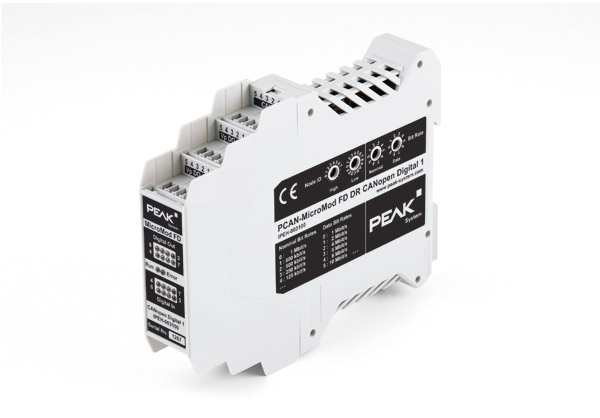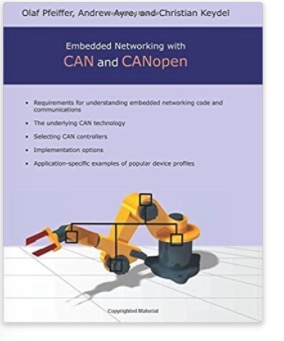Blog
Recent Posts
Digital I/O Module For Operations In CANopen And CANopen FD Networks
Posted by on
Peak-System Technik and EmSA (Embedded Systems Academy) have joined forces and developed the PCAN-MicroMod FD DR CANopen Digital 1, an I/O device with eight digital inputs and eight outputs.
The I/O module comes in a DIN-rail mountable housing with screw terminal strips. The eight digital inputs and eight digital outputs are galvanically isolated from the power supply, with an isolation voltage specified as 100 V. The digital data comply with the IEC 61131-2 standard and own a Type 3 characteristic. The digital outputs on a high-side switch basis can manage up to 500 mA each. Mechanisms such as thermal protection, short-circuit detection, and open-load detection improve the reliability of the outputs.
The CAN FD interface facilitates classic CANopen according to CiA 301 as well as CANopen FD (CiA 1301) communication. The CANopen FD protocol implementation is currently undergoing certification by CAN in Automation (CiA). All CANopen FD devices are required to pass this conformance test, while not needed for Classic CANopen interfaces.
The user can choose the node-ID and the bit-timing utilizing rotary switches. It is possible to operate either the CANopen FD or the Classic CANopen protocol stack. CANopen FD applies the SDO (service data object) protocol and the USDO (universal SDO) protocol to access the object dictionary of a CANopen (FD) device.
Technical Specifications
- I/O module for CANopen® and CANopen FD®
- Communication profiles according to CiA® 301 version 4.2.0 and CiA® 1301 version 1.0.0
- Device profile according to CiA® 401 version 3.0.0
- High-speed CAN connection (ISO 11898-2)
- Selectable CANopen bit rates:
Nominal: 20, 50, 125, 250, 500, 800, and 1000 kbit/s - Selectable CANopen FD bit rates:
Nominal: 250, 500, 800, and 1000 kbit/s
Data: 1, 2, 4, 5, 8, and 10 Mbit/s - NXP TJA1044GT CAN transceiver
- Galvanic isolation against the power supply up to 500 V
- Selectable CANopen bit rates:
- Configuration of the CAN and CAN FD bit rates as well as the node ID with rotary switches on the casing
- 2 LEDs "RUN" and "ERROR" for status indication according to CiA® DR 303-3
- 8 digital inputs
- Comply with the IEC 61131-2 standard
- Input characteristics: Type 3
- 2 groups of 4 inputs to be used either as sourcing or sinking inputs
- Galvanic isolation of the digital inputs 0 to 3 and 4 to 7 each up to 100 V against the module supply
- 8 digital outputs
- 500 mA load per High-side output
- Thermal protection per output
- Short circuit detection per output
- Open load detection in on-state and off-state per output
- LEDs for status indication of the digital inputs and outputs
- Connections for CAN, I/O, and power supply via 5-pole screw-terminal strips (Phoenix)
- Plastic casing (width: 22.5 mm) for mounting on a DIN rail (DIN EN 60715 TH35)
- Voltage supply from 8 to 36 V
- Extended operating temperature range from -40 to 85 °C (-40 to 185 °F)
Embedded Networking with CAN and CANopen
CAN (Controller Area Network) is a serial communication protocol that was originally developed for the automobile industry. CAN is far superior to conventional serial technologies such as RS232 in regards to functionality and reliability, and yet CAN implementations are more cost-effective.
CANopen, a higher layer protocol based on CAN, provides the means to apply the ingenious CAN features to a variety of industrial-strength applications. Many users, for example, in the field of medical engineering, opted for CANopen because they have to meet particularly stringent safety requirements. Similar requirements had to be considered by manufacturers of other equipment with very high safety or reliability requirements (e.g., robots, lifts, and transportation systems).
Providing a detailed look at both CAN and CANopen, this book, written by the founders of the Embedded Systems Academy, examines those technologies in the context of embedded networks. There is an overview of general embedded networking and an introduction to the primary functionality provided by CANopen.
Everything one needs to know to configure and operate a CANopen network using off-the-shelf components is described, along with details for those designers who want to build their CANopen nodes. The wide variety of applications for CAN and CANopen is discussed, and instructions in developing embedded networks based on the protocol are included. Also, references and examples using MicroCANopen, PCANopen Magic, and Vector's high-end development tools are provided.
 Loading... Please wait...
Loading... Please wait...


